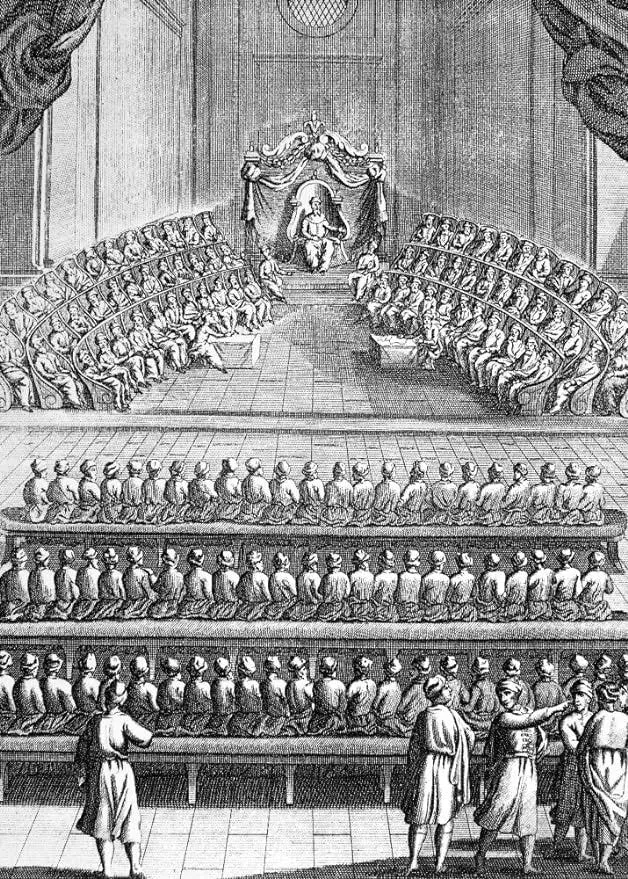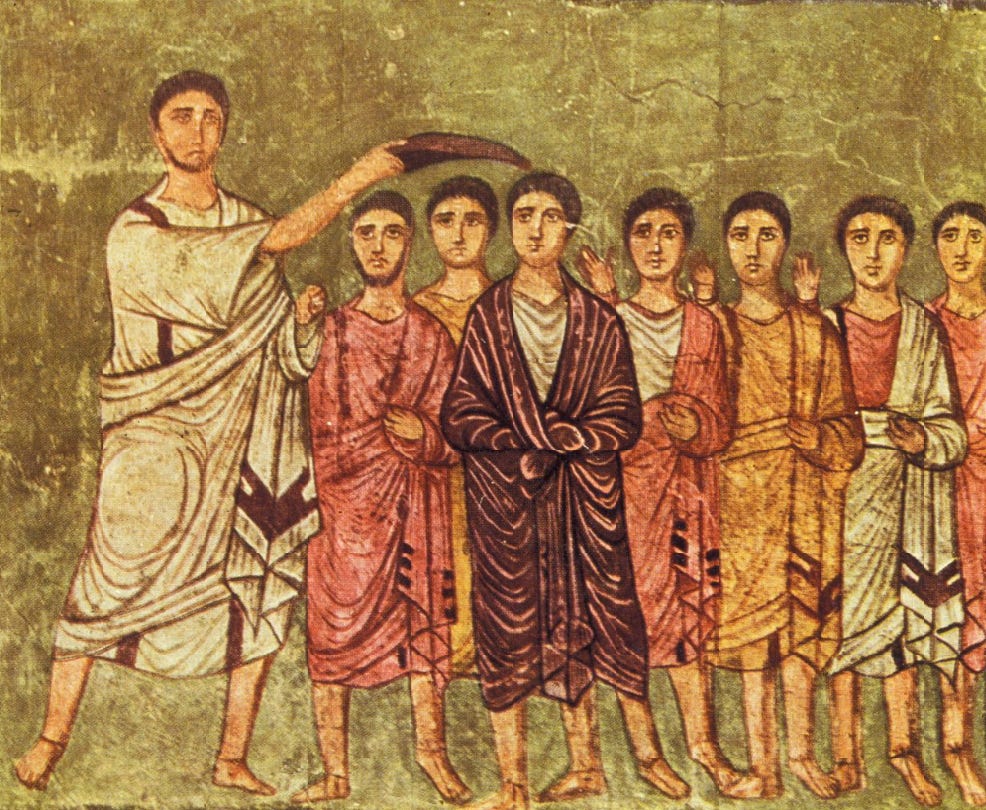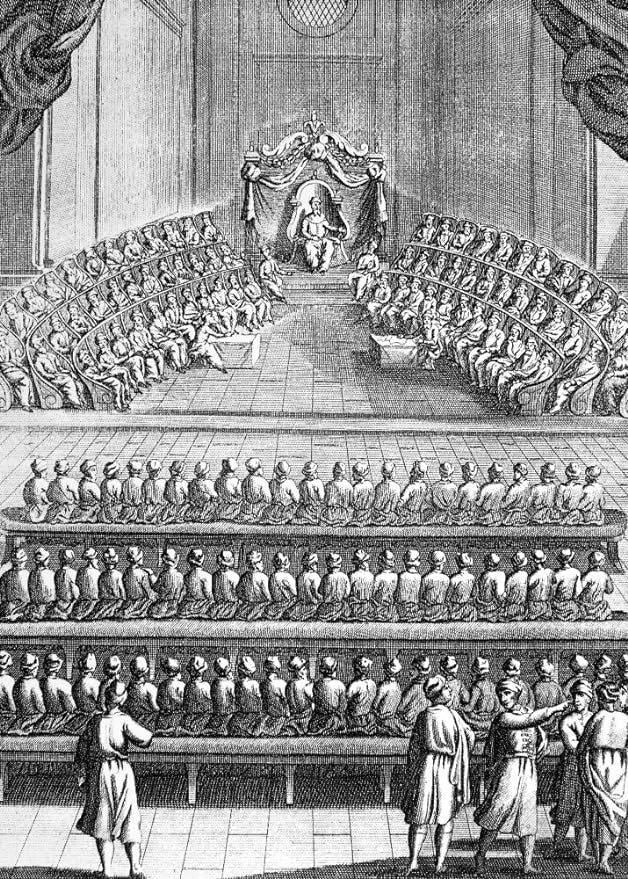adding more benches to the beit midrash
We do not need to be prisoners to our texts.

As we begin the next chapter of Life is a Sacred Text—in which I begin to center this work, and you—even more than before, I thought it might be apt to start with a piece that's been waiting to be finished for far too long–which encapsulates, in so many ways, a key piece (one of many)1 that's been in my head all along about this project, about my rabbinate, about my work–about why doing public Torah matters to me so much.
About why I insist on writing in places where anyone can congregate, writing about "Genesis" not "Bereshit" (or בראשית) – for starters. And a lot of the other choices of that sort– some of the things (besides “poor impulse control” and “warped sense of humor”) that have formed some of the bones of my work all along.
This essay is about one of the pieces of this puzzle.
It won't be a surprise to longtime readers, I don't think, but perhaps it's useful to spell out nonetheless? Here it is– a rant or manifesto or something, in the form of an annotation to a story in the Talmud, as is customary.
Anyway, I suppose this is the part where I remind you that I’ve gone indie; if you want to both support the labor that will go into these possibly increasingly feral (or polished, or both (?)) missives, and get a) more knowledge b) access to things like Ask the Rabbi threads, Zoom conversations, access to special classes taught by me, and more, it’s time to bump up to subscriber level. And as always, nobody is turned away because paying isn’t for you right now—hit me up and I’ll hook you up.2 Love giving away subscriptions, happy to do so.
AND if you’re able to subscribe, you can help subsidize my giving them away to others. Multiple tiers available for that reason.
OK, enough preamble. Let’s learn some Torah?3
There is a famous story4 in the Talmud (Brachot 27b-28a):
The Sages taught: There was an incident involving a student, who came before Rabbi Yehoshua. The student said to him: Is the evening prayer optional or obligatory? Rabbi Yehoshua said to him: Optional. The same student came before Rabban Gamliel and said to him: Is the evening prayer optional or obligatory? Rabban Gamliel said to him: Obligatory. The student said to Rabban Gamliel: But didn’t Rabbi Yehoshua tell me that the evening prayer is optional?
“But Other Dad said I didn’t have to do it! Why do youuuuu say I have toooo??”
The story is long, so I’ll summarize bits of it. Rabban Gamliel 5, who is the Nasi (head of the Sanhedrin, the religious SCOTUS/Congress of the early Rabbinic era), gets all huffy about the fact that this student is waving a divergent opinion in his face. (Never mind that the Sages disagreed all the time! There Is Huffiness.) He waits until it’s public lecture time and has the student ask again. Rabban G answers, and asks if anyone disagrees. Rabbi Yehoshua says “No,” out of respect, so as to not contradict the Nasi in front of everyone 6, but Rabban G calls out Rabbi Y and puts him on the spot. Awkward.
TL;DR Rabban G forces Rabbi Y to stand during Rabban G’s whole lecture—to be publicly humiliated, as punishment for daring to rule differently than he did.
And since this was not the first, not the second, but the third time Rabban Gamliel had pulled this kind of power garbage over Rabbi Yehoshua, folks got well and truly fed up. So, the people said:
Let us remove him from his position as Nasi. It was so agreed, but the question arose: Whom shall we establish in his place? Shall we establish Rabbi Yehoshua in his place? The Sages rejected that option because Rabbi Yehoshua was party to the incident for which Rabban Gamliel was deposed.
Messy. OK, onward.
(They debate who else could take his place, who won’t be vulnerable to curses [important, OK??] and eventually get to:)
Rather, suggested the Sages, let us establish Rabbi Elazar ben Azarya in his place, He is wise, rich, and a tenth generation descendant of Ezra. The Gemara explains: He is wise, so if Rabban Gamliel raises a challenge in matters of Torah, he will answer it and not be embarrassed.
Torah smackdown: Bring it on.
And he is rich, so if the need arises to pay homage to the Caesar’s court and serve as a representative of the Jews to lobby and negotiate, he has sufficient wealth to cover the costs of the long journeys, taxes, and gifts, so he too is able to go and pay homage.
Qualities needed for ancient Jewish leadership include: “Personal cash on hand in order to pay off the Romans.” (Hope the vacation package was good, at least?)
It was taught: On that day that they removed Rabban Gamliel from his position and appointed Rabbi Elazar ben Azarya in his place, there was also a fundamental change in the general approach of the study hall as they dismissed the guard at the door and permission was granted to the students to enter.
“They dismissed the guard and permission was granted for the students to enter.”
This really is such a profound revelation, that sentence, above. Unlike, say:
“The selection was not a deliberate selection. It was kind of intuitive over the years; it just fell together that way. The people had to meet a couple criteria, but it was just kind of my personal interest and love of them.”
Ah, yes, that’s the longtime Rolling Stone editor in chief Jann Wenner some months ago attempting to justify the fact that his book on “Legends of Rock” mysteriously only contained cis white dudes. He continued:
Insofar as the women, just none of them were as articulate enough on this intellectual level…You know, Joni was not a philosopher of rock ’n’ roll. She didn’t, in my mind, meet that test… Of Black artists — you know, Stevie Wonder, genius, right? I suppose when you use a word as broad as “masters,” the fault is using that word. Maybe Marvin Gaye, or Curtis Mayfield? I mean, they just didn’t articulate at that level.
In other words: he was (and is) a racist, misogynistic putz who thinks the true “philosophers of rock” (what a pretentious phrase) are guys who sing approvingly about the sexual assault of enslaved African girls (all the trigger warnings at that link) instead of JONI MITCHELL OR JOAN ARMATRADING OR JANELLE MONÁE or NINA SIMONE or PATTI SMITH. Uh-huh.7
This justification for running a huge segment of the rock industry for decades—”intuitive”—oddly enough corresponds, as it so often does, to “like me.”
The problem is, of course, that in every single field out there–every single one–there are similar people holding power– tons of them, rampant – who are similarly racist, sexist, homophobic, transphobic, ableist, etc. or some combination therein, who have been doing a similarly admirable job of shaping entire fields, entire industries—mostly without getting caught by saying the wrong thing to the New York Times.
People who have been doing this for centuries—deciding who is in, who is out: they decide, and on what terms.
More recently, we’ve seen thin-skinned white men crowing over the end of Harvard President Claudine Gay’s tenure, making sure that people are clear that this deliberate smear campaign—spearheaded by the guy who engineered the national panic about so-called “Critical Race Theory” —will be used as a way to keep countless more people out, spewing garbage like:
the social-justice model of higher education, currently centered on diversity, equity and inclusion efforts…blew up the excellence model
Suddenly we're not even talking about an individual, but impugning entire "models" to increase general suspicions of any scholars of color– as though the white boys’ “excellence model” wasn’t so often more like the, “grandpa made a donation” model or the “dad was in the same fraternity as the provost” model. 8
Isn’t that always how it goes?
It happens in every industry.
Every field.
Every community.
The word is so cliche it's become a TikTok meme: Gatekeepers.
The problem is, so often, it's not that the people who do it are trying to be mean.
(yes: so often it's us, it's all of us at various points, when we operate from a place of complacence, ignorance, fear, laziness, anxiety, and so forth.)
- It's so nice to tap your friends to teach webinars! And I'm not sure I know who else I could reach out to for this?
- Our congregation has some clear ideas about what it's looking for in its next leader.
- But this is the perfect venue! It could be hard to navigate in places– but it'll be OK, right?
- I've heard really good things about this one candidate from people I know.
- I just think...you know, the text says what it says, there's nothing you can do.

But it doesn’t have to be that way.
It was taught: On that day that they removed Rabban Gamliel from his position and appointed Rabbi Elazar ben Azarya in his place, they dismissed the guard at the door and permission was granted to the students to enter.
PERMISSION WAS GRANTED TO THE STUDENTS TO ENTER.
Instead of Rabban Gamliel’s selective approach, the new approach asserted that anyone who seeks to study should be given opportunity to do so. As Rabban Gamliel would proclaim and say: Any student whose inside are not like their outside will not enter the study hall.
Rabbi Adin Steinsaltz’ annotation of this story—which, like the rest of it, would have appeared in the non-bold text had I not deleted it (the bold, as usual, is the original Aramaic/Hebrew, depending, and intact)—suggested that the “inside like their outside” has to do with thoughts vs conduct, but Rabbi Dr. Aryeh Cohen disagrees, and suggests that it
”probably had to do with class, I.e. inside = what you know, outside = what you wear. What you wear in the garb of the times was a philosopher’s cloak or the like.”
The philosopher’s cloak, as pictured in the image above, one of the amazing 3rd century wall paintings in the synagogue at Dura Europos, in present-day Syria.
This tracks in many ways with the image Rabban Gamliel seems to have painted for himself up to this point—elitist, concerned with his honor and presumably optics, focused on defining who’s in and who’s out (more on that below), clueless about financial hardship (ditto). This does seem to be a guy who’d care what his students would wear, doesn’t it?
Not every prospective student could afford those threads, by a long shot. (And perhaps that wasn't even what everyone would prefer to wear! I don't have the answer to that one. Guessing that the garb would be regarded as pretty universal– but worth considering as a question.)
But the new Nasi removed the barriers to access: A literal guard, and more critically, a financial and possibly cultural barrier. And suddenly– the study hall/beit midrash is a different kind of a place.
The Gemara relates: On that day several benches were added to the study hall to accommodate the numerous students. Rabbi Yoḥanan said: Abba Yosef ben Dostai and the Rabbis disputed this matter. One said: Four hundred benches were added to the study hall. And one said: Seven hundred benches were added to the study hall.
SO MANY students came to learn when there wasn’t someone whose job it was to tell them to go away because they weren’t good enough. Students filled all the benches (each of which possibly, viz the illustration below, held a row of students).
When he saw the tremendous growth in the number of students, Rabban Gamliel was disheartened. He said: Perhaps, Heaven forbid, I prevented Israel from engaging in Torah study.
To his credit, he has the good sense to feel bad about it! This is a growth process that doesn't always happen from gatekeepers– but it reminds us that it's possible. But, as we’ll see in a moment, he’s still set in old ways of thinking.

It was taught: There is a tradition that tractate Eduyyot was taught that day. And everywhere they say:.. There was no halakha whose ruling was pending in the study hall that they did not explain and arrive at a conclusion.
“On that day, there was no pending Jewish legal matter that they did not address and resolve”
They got work done.
The new more open ethos was, it turns out, not only more just but also great for productivity.
- Is that because more new ideas came in, from fresh voices and novel perspectives?
- Because people with Beginner’s Mind asked questions that were too often (erroneously) taken for granted?
- Because more people feeling welcomed meant that there was incredible energy in the space?
- Because even the Rabban Gamliel-approved students were impacted by the buoyant vibe and brought their A-game as a result?
I dunno. But more space for more people resulted in more Torah—and better Torah.
And even Rabban Gamliel did not avoid the study hall for even one moment.
There was too much fire in that room for even Rabban G to stay away out of huffiness!
You'll see why I'm including this whole back and forth (below) in a second:
As we learned in a mishna: On that day, Yehuda, the Ammonite convert, came before the students in the study hall and he said to them: What is my legal status in terms of entering into the congregation of Israel, i.e., to marry a Jewish woman? Rabban Gamliel said to him: You are forbidden to enter into the congregation. Rabbi Yehoshua said to him: You are permitted to enter into the congregation. Rabban Gamliel said to Rabbi Yehoshua: Wasn’t it already stated: “An Ammonite and a Moabite shall not enter into the congregation of God; even to the tenth generation shall none of them enter into the congregation of the Lord forever” (Deuteronomy 23:4)? How can you permit him to enter the congregation? Rabbi Yehoshua said to Rabban Gamliel: Do Ammon and Moab reside in their place? [The Neo-Assyrian king] Sennacherib9 already came and, through his policy of population transfer, scrambled all the nations and settled other nations in place of Ammon. Consequently, the current residents of Ammon and Moab are not ethnic Ammonites and Moabites, as it is stated in reference to Sennacherib: “I have removed the bounds of the peoples, and have robbed their treasures, and have brought down as one mighty the inhabitants” (Isaiah 10:13). And although it is conceivable that this particular convert is an ethnic Ammonite, nevertheless, there is no need for concern due to the Jewish legal principle: Anything that parts from a group parts from the majority, and the assumption is that he is from the majority of nations whose members are permitted to enter the congregation.
Rabban Gamliel said to Rabbi Yehoshua: But wasn’t it already stated: “But afterward I will bring back the captivity of the children of Ammon, says the Lord” (Jeremiah 49:6) and they have already returned to their land? Therefore, he is an ethnic Ammonite and he may not convert. Rabbi Yehoshua said to Rabban Gamliel: That is no proof. Wasn’t it already stated in another prophecy: “And I will turn the captivity of My people Israel and they shall build the waste cities, and inhabit them; and they shall plant vineyards, and drink the wine thereof; they shall also make gardens, and eat the fruit of them” (Amos 9:14), and they have not yet returned? In rendering the ruling, only proven facts may be taken into consideration. They immediately permitted him to enter the congregation.
Rabban G, as usual, tried to understand things in the most literalist, gatekeeping, exclusivist way—his way, sure, errs on the side of “better safe than sorry” (if we want to be generous to his internal perspective)10 but his approach nonetheless did harm to a real person in the room.
What’s theoretical to Rabban Gamliel is personal indeed to Yehuda, a Jew—every bit a Jew as Rabban Gamliel himself, mind you—who is forthright about his ethnic origins, knowing well that Biblical-era animosity led to a prohibition 11 that might work against him.12 He asks in integrity, knowing well that the Sages of the Sanhedrin may rule that he is forbidden to marry.
What is an abstract legal principle to Gamliel is a question of whether or not Yehuda will be allowed companionship, love, intimacy—or be doomed by the esteemed scholars to a life of loneliness.
Rabbi Yehoshua argues not for the more isolated, literal meaning of the text, but, rather, thinks expansively.
He brings in historical context and deduces logic from information (Sennacherib’s actions must have impacted our ability to know who’s what anymore!) He brings rabbinic legal principles. When Rabban Gamliel tries to parry with another literal quote, Rabbi Yehoshua counters by comparing them to us.
Rabbi Yehoshua re-centers Yehuda's humanity. He reminds Rabban Gamliel, and everyone in the room, that Amonites are human people with as complicated as story as our own–and, implicitly, that Yehuda is as worthy of care, compassion, and consideration as anyone with a less-tricky pedigree.
Dropping the gakekeepers means also dropping the gatekeeping approach to our thinking.
We do not need to be prisoners to our texts.
- We are not required to use only the most literalist reading, devoid of context or logic.
- We are not required to pretend that real people are not impacted by our analyses.
- We should not think about questions about “them” without applying those same questions to “us.”
And had the old gatekeeper been in charge—had Rabban Gamliel still helmed the Sanhedrin—it’s likely that Yehuda would have been told: “No. Sorry, even though you’re a Jew now, and you seek to live your entire life in the Jewish community, bound by Jewish law—you cannot marry.”13
But now—the gatekeeper was out, and a more just, inclusive way of reading was allowed to carry the day! Rabbi Yehoshua really shows us what contemporary Orthodox feminist Blu Greenberg means when she (famously) says,
“Where there's a rabbinic will, there's a [Jewish legal] way.”
Yehuda is welcomed in—not left behind.
And this is just further proof that we cannot fully understand our sacred texts if we keep throwing the same old perspectives at them again and again.
We need new brilliances to keep unlocking everything hiding inside them.
What might Yehuda the Ammonite Jew-by-choice notice that his mentors missed? What ways of thinking could he bring?
Which is, of course, the real tragedy and evil of all of that gatekeeping—all the Torah, all the art, all the scholarship, all of the geopolitical leadership that we have already lost because of those already kept out. All the love denied. All of the ways the world has been shaped by “No”s.
We can’t spare another moment trying to make up for centuries of lost time.
There’s too much at stake now, today.
So how did the story end?? To his credit, Rabban Gamliel’s transformation continued:
Rabban Gamliel said to himself: Since this is the situation, that the people are following Rabbi Yehoshua, it would be appropriate for me to go and appease Rabbi Yehoshua.14 When he reached Rabbi Yehoshua’s house, he saw that the walls of his house were black. Rabban Gamliel said to Rabbi Yehoshua in wonderment: From the walls of your house it is apparent that you are a blacksmith, as until then he had no idea that Rabbi Yehoshua was forced to engage in that arduous trade in order to make a living. Rabbi Yehoshua said to him: Woe unto a generation that you are its leader as you are unaware of the difficulties of Torah scholars, how they make a living and how they feed themselves.
"How cute that you thought all scholars could just sashay around in pretty philosopher’s cloaks, Rich Boy, but some of us have to work for a living."
Many people raised with privilege have that moment when they start to understand that not everyone else has what they have.
It's always a problem when those who haven't done the learning needed to lead responsibly have more power than understanding. (And, of course, an even bigger problem is when malicious actors are able to drive the agenda.)
Anyway, eventually Rabban Gamliel apologizes for insulting Rabbi Yehoshua, and everybody comes up with an arrangement wherein Rabban Gamliel and Rabbi Elazar ben Azarya share duties as head of the Sanhedrin, switch off who gets to give the weekly lecture, all’s well in Yavneh once again.
And to his credit, Gamliel actually learned, this time–or over time. His final act—the man who was once so attached to his honor that he would would publicly humiliate anyone who challenged it; who took prestige so seriously that he placed guards to ensure that his students were well-dressed; who read law erring on the side of exclusivity– this man eventually chose to lower his own status in death, in order to set an accessibility precedent for everyone.
He was, as Nasi of the Sanhedrin, entitled to a fancy-shmancy sendoff—and kavod hamet—the honor of the dead—is a huge principle in the tradition, as the beginning of this last story illustrates.
But Rabban Gamliel finally got it.
Making things accessible to others is the most crucially important thing.
More, even, than one’s own final opportunity for honor.
Initially, the funeral expenditures for the deceased were more taxing for relatives than the death, as the burials were opulent, until it reached a point where people would abandon the deceased and flee. This continued until Rabbi Gamliel came and conducted himself in a self-deprecatory manner,15 instructing the people that they were to take him for burial in plain linen garments. And all the people conducted themselves following his example, and instructed their families to take them for burial in plain linen garments. (Talmud Ketubot 8b)
A few takeaways:
You can’t just assume people will come in to wherever you are.
Or that they can.
Even if you don’t think you’re keeping any gates.
We all must actively seek out and dismantle barriers.
—the racism and the ableism and the transphobia and financial barriers and assumptions about neurotype and and.
Structural changes have to happen both at the door and in the very workings of the proverbial study house itself.
Leaders must lead by making sure everyone can get in, by inviting novel, radical perspectives and, even, dropping their own entitlements in order to show what access can look like by example.
And it might be a long process. A lifelong one– a humbling one, one that happens in fits and starts, progress and then a new realization about assumptions we didn't even know we held. It's ok. All we have is the work, but we must do the work.
It’s the only way to create the Torah, and the world, that is truly for—and by—everyone.
Like this? 🌱 Get more:
To get new posts and to support the labor that enables this project to exist, become a free or paid subscriber. Get substantial essays like this for free, and paid subscribers get even more text and provocation, on the regular.
Life is a Sacred Text is a reader-supported publication.
And please know that if you want into the Thursday conversations but paying isn’t on the menu for you right now, we’ve got you. Just email lifeisasacredtext@gmail.com for a hookup. (Thanks for your patience as we sort out the New Platform Bugs over here.)
Please share this post with friends and on social media if it resonated with you.
💖 Sending a big pile of blessings and goodness your way. 💖
1 Not the only piece! There are a lot of pieces! I feel like a dang Tetris game in here sometimes! (Though maybe I should do a lil’ mini-series about some of the pieces? Hmm.)
2 LifeIsASacredText@gmail.com as always. May be a minute to respond as we figure out some stuff about this new platform, but it'll happen.
3 As usual, with Talmud, bold is the original text and Roman is the commentary by Rabbi Adin Steinsaltz added in to help clarify stuff.
4 As always: If you’re one of those nerds who thinks that there are “famous stories” in the Talmud.
5 Christian friends, this isn’t the Rabban Gamliel you know from your texts; that’s this dude’s grandfather. He’s known as Rabban Gamliel I, this one is Gamliel II, and today’s story takes place after the Destruction of the Temple in 70 CE, but before the Bar Kochba Revolt in 132 CE.
6 And/or to not get humiliated in public again (keep reading)
7 Related: Universe: Please please give us that Janelle Monáe/Joan Armatrading collab we all deserve??
8 Highly, highly recommend Ijeoma Oluo’s Mediocre: The Dangerous Legacy of White Male America to learn about how the earliest systems of academia were designed to keep BIPOC out—many of which continue to exist today (SATs, anyone?) and about the creation of so many other forms of American systemic gatekeeping.
9 Sennacherib was the king of the Neo-Assyrian Empire from 705 BCE until 681 BCE. An Ancient Near Eastern rebellion against Assyrian rule in 705 BCE lead to Sennacherib’s leading a military campaign in 701 BCE that– had the expected results of a massive imperial army going hard against a provincial rebellion. May have to write about that at some other point, there's lots more to say.
10 IE “Better to tell you no than to sanction a sin that I see stated explicitly in the Torah! Sorry!'
11 Riddled, though it may be, with contradictions. Presumably because of Biblical era real-life animosities, Deuteronomy 23:4 specifies that neither Ammonite or a Moabite—or their descendants may “enter into the community of God.” And yet, the biblical Moabite Ruth married not one but two Judean men (we meet her as a young widow) and was the ancestor of not only King David but, according to Rabbinic thinking, will thus also be an ancestor to the Messiah. Additionally, Naamah, an Amonite, was married to King Solomon and the mother of Rehoboam, King of Judah. (The Rabbis of course make exemptions for just them, natch. 🙄) There were also many intermarriages between Ammonites and Moabites and Israelites and Judeans (map here) both in the days of Nehemiah and later.
12 This is where I want to write a whole essay on the construction of ethnicity and identity in Yehuda the Ammonite Jew By Choice’s Beit Midrash Question and believe me, I started and deleted because this is all long enough as is.
13 Cannot marry a Jew, in any case, but that’s what he wanted and was asking for.
14 If I understand Rabbi Adin Steinsaltz's annotation correctly (and I thought I did, and then I wasn't sure, and now it's late and I'm not going to check again) I think? he thinks that Rabban G believes that since everybody's following R. Yehoshua, I guess he's right about our little Jewish legal spat, better go concede because he won the argument," and I don't see that in the Aramaic (or Rashi) anywhere– I see, "Welp, everybody's following R. Yehoshua, time to swallow my pride and apologize for being a jerk,” without conceding any specific Jewish legal positions. What he apologizes for is insulting R. Yehoshua—and it seems to (me to) be the case that he does so because he’s lost authority. It’s OK. Transformation takes time, and as we’ll see, this visit is part of that work.
15 In Ketubot 8b it says רַבָּן גַּמְלִיאֵל וְנָהַג קַלּוּת בְּעַצְמוֹ, and in Moed Katan 27b, the same story is related with the language רַבָּן גַּמְלִיאֵל וְנָהַג קַלּוּת רֹאשׁ בְּעַצְמוֹ.

